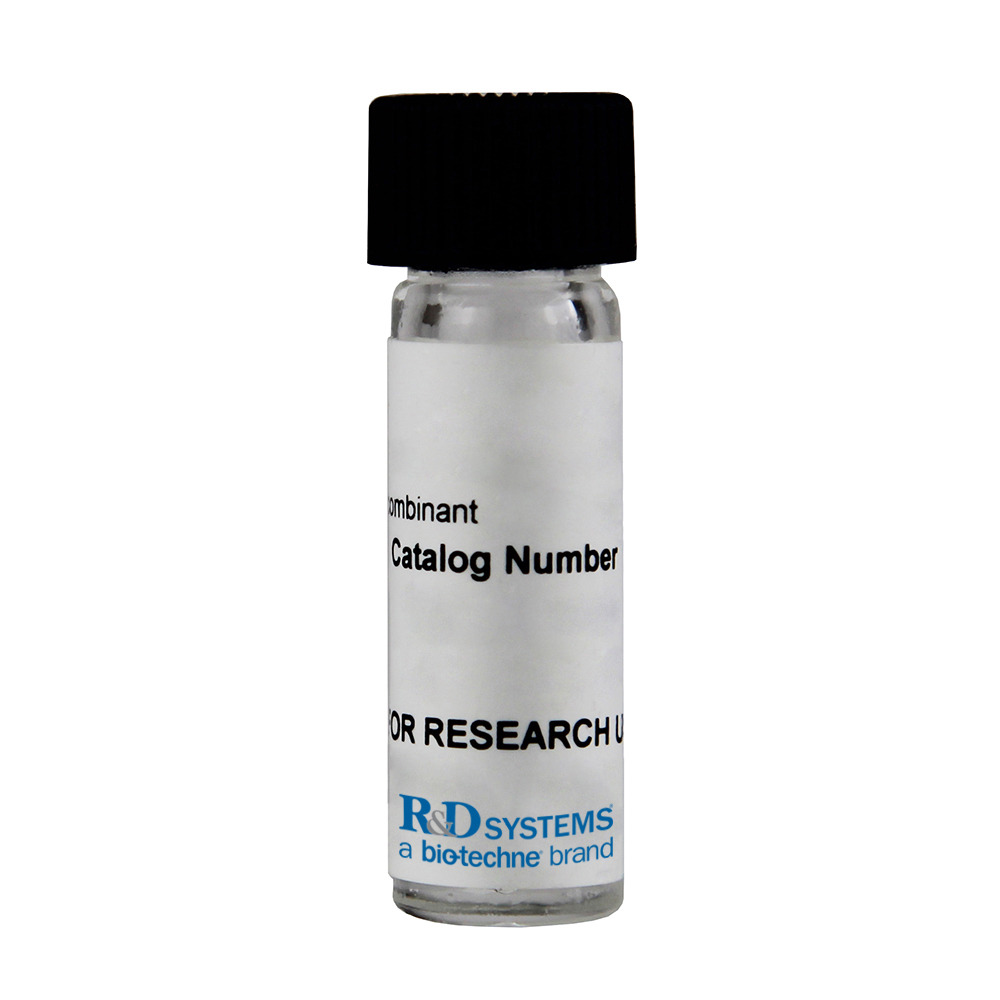

 下载产品说明书
下载产品说明书 下载SDS
下载SDS 用小程序,查商品更便捷
用小程序,查商品更便捷



 收藏
收藏
 对比
对比 咨询
咨询Carrier Free
CF stands for Carrier Free (CF). We typically add Bovine Serum Albumin (BSA) as a carrier protein to our recombinant proteins. Adding a carrier protein enhances protein stability, increases shelf-life, and allows the recombinant protein to be stored at a more dilute concentration. The carrier free version does not contain BSA.
In general, we advise purchasing the recombinant protein with BSA for use in cell or tissue culture, or as an ELISA standard. In contrast, the carrier free protein is recommended for applications, in which the presence of BSA could interfere.
6624-AG
| Formulation | Lyophilized from a 0.2 μm filtered solution in PBS. |
| Reconstitution | Reconstitute at 300 μg/mL in PBS. |
| Shipping | The product is shipped at ambient temperature. Upon receipt, store it immediately at the temperature recommended below. |
| Stability & Storage: | Use a manual defrost freezer and avoid repeated freeze-thaw cycles.
|
Recombinant Human Agrin Protein, CF Summary
Product Specifications
Optimal dilutions should be determined by each laboratory for each application.
Ala1260-Pro2045, with an N-terminal 6-His tag
Analysis

Background: Agrin
Agrin is a 400‑600 kDa heparan sulfate proteoglycan component of the extracellular matrix. The N-terminal half of human Agrin, which mediates ECM interactions, contains a Laminin-binding NtA domain, nine Kazal-type protease inhibitor domains, two Laminin EGF-like domains, and one SEA domain. The C‑terminal half contains four EGF-like repeats and three Laminin globular G domains. Rat Agrin lacks the NtA domain, and mouse and chick Agrin include the NtA domain only by the use of an alternate promoter. Additional isoforms are generated by alternate splicing at sites Y and Z in the C‑terminal half of rat Agrin (known as A and B, respectively in chick). Agrin isoforms that contain an insert at site Z (Z+ forms) are known as neural Agrin and are selectively produced by motoneurons. Other isoforms are known as muscle Agrin and are additionally expressed in non-neuronal tissues, particularly in basement membranes of the lung and kidney (1-3). This recombinant protein consists of the C‑terminal half of human Agrin corresponding to the Z- isoform of rat Agrin. It shares 60%, 78%, and 80% amino acid sequence identity with comparable regions of chick, mouse, and rat Agrin, respectively. The C‑terminal half of Z- and Z+ Agrin binds to alpha ‑Dystroglycan and mediates adhesion between motoneurons and myotubes at the neuromuscular junction (NMJ) (4-6). In contrast, only Z+ Agrin is effective at inducing clustering of the postsynaptic Acetylcholine Receptor (AChR) and presynaptic motoneuron differentiation (7, 8). Agrin-induced AChR clustering requires a myotube receptor complex that contains alpha ‑Dystroglycan, MuSK, and LRP4 (4, 9-11). Agrin exhibits many functions in addition to NMJ development. It is enriched in senile Alzheimer's disease plaques where it binds the A beta (1‑40) peptide and promotes amyloid fibril formation (12). It regulates neuronal excitability by binding and inhibiting the alpha 3 subunit of the neuronal Na/K ATPase (13). It functions as an epithelial cell attachment receptor for HIV-1 through interactions with the gp41 coat protein (14). During T cell activation, Agrin contributes to formation of the immunological synapse and regulates the threshold of T cell activation (15).
- Jury, E.C. and P.S. Kabouridis (2010) Arthritis Res. Ther. 12:205.
- Bezakova, G. and M.A. Ruegg (2003) Nat. Rev. Mol. Cell Biol. 4:295.
- Groffen, A.J.A. et al. (1998) Eur. J. Biochem. 254:123.
- Gee, S.H. et al. (1994) Cell 77:675.
- Sugiyama, J. et al. (1994) Neuron 13:103.
- Gesemann, M. et al. (1998) J. Biol. Chem. 273:600.
- Burgess, R.W. et al. (1999) Neuron 23:33.
- Ferns, M.J. et al. (1993) Neuron 11:491.
- Glass, D.J. et al. (1996) Cell 85:513.
- Kim, N. et al. (2008) Cell 135:334.
- Zhang, B. et al. (2008) Neuron 60:285.
- Cotman, S.L. et al. (2000) Mol. Cell. Neurosci. 15:183.
- Hilgenberg, L.G.W. et al. (2006) Cell 125:359.
- Alfsen, A. et al. (2005) Mol. Biol. Cell 16:4267.
- Khan, A.A. et al. (2001) Science 292:1681.









 危险品化学品经营许可证(不带存储) 许可证编号:沪(杨)应急管危经许[2022]202944(QY)
危险品化学品经营许可证(不带存储) 许可证编号:沪(杨)应急管危经许[2022]202944(QY)  营业执照(三证合一)
营业执照(三证合一)